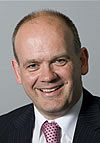This morning the Environment Committee took evidence from experts on the controversial Heathrow third runway proposal. In the green corner were Cllr Barbara Reid representing the M2 group of councils and John Stewart from HACAN. In the commercial corner were BAAs directors of corporate responsibility and airport communications.
Noise
Noise was the main concern for members. The government use 2002 as the baseline year for measuring trends but as this was the last year of Concorde's operation there is concern that successive years do not compare fairly. Concorde was a very noisy aircraft, with an effect equal to 120 Boeing 757s, so measuring against 2002 leaves room for more flights without compromising the headline downward trend.
Use of the 57 decibel contour was also challenged as this defined an area which didn't include Putney and Fulham - places where aircraft noise levels generate many complaints. Less than 300,000 people fall within the contour but HACAN estimate that more than twice that number are affected.
BAA highlighted the phasing out of noisy, polluting planes, including Concorde, which would ensure less noise pollution in future.
Air Quality
Witnesses from the Environment Agency admitted that the 2010 air quality targets for the UK would be failed, resulting in large fines for the Government. BAA explained the measures they were taking to reduce pollution.
At Heathrow much of the pollution comes from vehicles taking passengers and workers to the airport. BAA were working to encourage green vehicles within the airport perimeter and had measures in place to encourage public transport use. 41% of journeys to the airport used public transport and this was one of the highest figures in Europe. The committee were still concerned that more could be done and suggested lowering the Heathrow Express fares to encourage more passengers. BAA were also investing in Crossrail and funding the Heathrow Express.
Pollution from aircraft would reduce with the arrival of cleaner and more efficient engines.
Global Impact
John Stewart reassured us that he was not opposed to the airport but that he wanted to see short haul flights phased out and replaced by high speed rail. This would create capacity for the existing runways to accommodate more long haul flights without expanding overall capacity.
However two thirds of emissions come from long haul flights and an increase in these might actually create more pollution. Furthermore, reducing capacity at the Heathrow hub might just encourage passengers to use the airports at Paris or Amsterdam instead. This would harm London's economy without mitigating damage to the environment.
Thursday, November 05, 2009
Subscribe to:
Post Comments (Atom)

1 comment:
RE wrote "Furthermore, reducing capacity at the Heathrow hub might just encourage passengers to use the airports at Paris or Amsterdam instead. This would harm London's economy without mitigating damage to the environment."
Why do people compare London's Heathrow with Amsterdam's Schipol or Paris Charles de Gaulle (CDG)?.
How many runways does London need?. When you add all the runway capacity in London, we have more runways then either Paris or Amsterdam. We have Luton, Stanstead, London City Airport, Gatwick, Biggin Hill, Northolt (RAF/private jets) and Heathrow. Heathrow may only have two runways but operates at a higher capacity then CDG or Schipol.
Perhaps, London should be more concerned about driving people out of the capital because of aircraft noise. I love living in London, but I do want my peace and tranquility when I am home. Even small pleasures such as walking along River Thames are interrupted by the constant drone of aircraft noise. (Aircraft follow the route to the river)
Which part of London should I move to avoid being bombarded by aircraft noise?.
Post a Comment